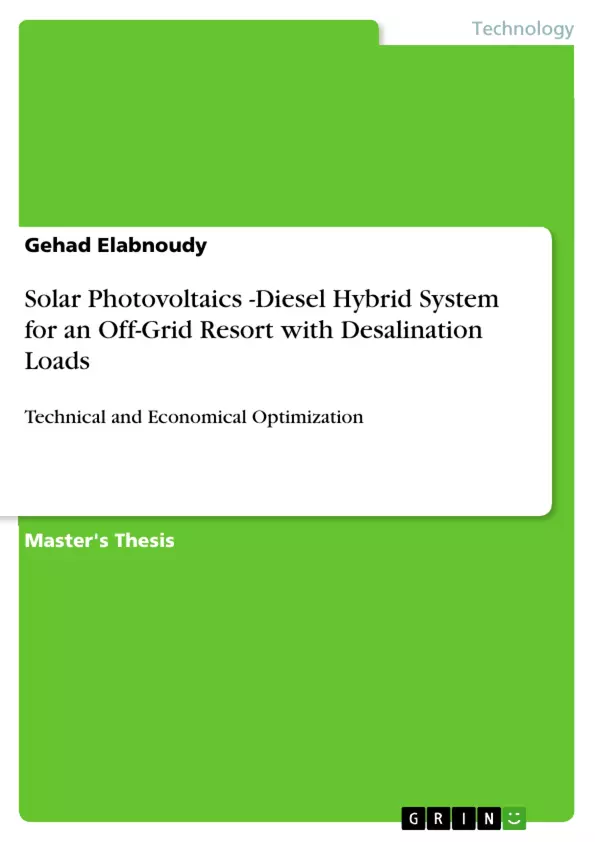The thesis shows the process of sizing and optimizing a solar Photovoltaics (PV) system for an off-grid resort with desalination loads in Marsa Alam, Egypt. Through load profile management, an optimal hybrid solar PV-diesel system, in the sense of maximum solar share that could be achieved without using energy storage while avoiding surpluses, is analyzed and presented. The self- consumption analysis aim was to determine the optimal PV system size in two load profile case scenarios that would give a SCR of not less than 90 percent to avoid surpluses in the hybrid system. Then an economic analysis for the optimal system sizes was conducted to measure and compare the economic benefits of implementing a hybrid solar PV-diesel system. It accounts for three different scenarios for the projection of future diesel prices in Egypt.
Inhaltsverzeichnis (Table of Contents)
- ACKNOWLEDGEMENTS
- CONTENTS
- LIST OF FIGURES
- LIST OF TABLES
- LIST OF ACRONYMS AND SYMBOLS
- ABSTRACT
- CHAPTER 1: INTRODUCTION
- MOTIVATION
- RESEARCH OBJECTIVES
- THESIS STRUCTURE
- CHAPTER 2: STATE OF THE ART OF A SOLAR-PV DIESEL HYBRID SYSTEM
- CHAPTER 3: OVERVIEW OF EGYPT'S ELECTRICITY SECTOR
- INTRODUCTION
- EGYPT'S ENERGY SECTOR
- SOLAR ENERGY RESOURCES AND POTENTIAL IN EGYPT
- RED SEA ENERGY SITUATION
- CHAPTER 4: SOLAR PV SYSTEM YIELD SIMULATION
- SELECTED LOCATION, SITE DESCRIPTION AND SOLAR ENERGY POTENTIAL
- CURRENT ENERGY SUPPLY SYSTEM IN THE OFF-GRID RESORT
- ENERGY GENERATION FROM SOLAR PV AND YIELD SIMULATION
- Location and weather data- input simulation parameters
- Solar PV array characteristics- input simulation parameters
- DC-AC inverter characteristics- input simulation parameters
- input simulation parameters- Pre-determined losses
- PVSYST analysis and yield forecast
- CHAPTER 5: LOAD PROFILE CONSTRUCTION
- METHODOLOGY
- ANNUAL LOAD PROFILES CONSTRUCTION
- Construction of the annual hotel load profile without desalination load
- Construction of the total annual load profile of the off-grid resort
- CHAPTER 6: DEMAND-SIDE MANAGEMENT
- Shifting the desalination operating hours to sunshine hours
- CHAPTER 7: ANNUAL SELF-CONSUMPTION ANALYSIS
- METHODOLOGY
- SELF-CONSUMPTION ANALYSIS FOR DIFFERENT LOAD PROFILE SCENARIOS
- Scenario 1: Current load profile (current desalination schedule)
- Scenario 2: New load profile (shifted desalination operation to sunshine hours)
- COMPARISON OF THE RESULTS FOR THE SCENARIOS
- CONCLUSION
- CHAPTER 8: ECONOMICAL ANALYSIS
- METHODOLOGY
- ECONOMICAL ANALYSIS FOR DIFFREENT SOLAR PV SYSTEM SIZES
- Diesel price scenarios in egypt
- PV-hybrid system CAPEX & OPEX
- LCOE from PV calculation
- Profitability measures results (Fuel cost savings, NPV, equity IRR, payback period)
- Alternative financing options
- COMPARISON OF RESULTS
- CONCLUSION
- CHAPTER 9: ENVIRONMENTAL IMPACT AND CO2 EMISSION SAVINGS
- CHAPTER 10: CONCLUSION
Zielsetzung und Themenschwerpunkte (Objectives and Key Themes)
This master's thesis explores the technical and economical optimization of a solar PV-diesel hybrid system for an off-grid resort in Egypt, focusing on incorporating desalination loads into the system. The research aims to evaluate the feasibility and benefits of utilizing solar energy to meet the resort's energy demands while minimizing reliance on diesel generators.
- Evaluating the integration of desalination loads into a solar PV-diesel hybrid system.
- Analyzing the technical feasibility of using solar PV to meet the resort's energy requirements.
- Conducting an economic analysis to assess the profitability and financial viability of the proposed hybrid system.
- Quantifying the environmental impact and CO2 emission savings achieved through the implementation of the hybrid system.
- Exploring demand-side management techniques to optimize the use of solar energy and reduce reliance on diesel generators.
Zusammenfassung der Kapitel (Chapter Summaries)
The thesis begins with an introduction, outlining the motivation for the research, the defined objectives, and the structure of the thesis. Chapter 2 provides a comprehensive overview of the state-of-the-art in solar PV-diesel hybrid systems, exploring their design, operation, and existing research. Chapter 3 delves into Egypt's electricity sector, examining the current energy situation, the potential of solar energy resources, and the specific energy challenges in the Red Sea region.
Chapter 4 focuses on the simulation of a solar PV system's energy yield, considering the location, site description, and available solar energy potential. It details the current energy supply system at the resort and explores the potential of solar PV to meet its energy requirements. Chapter 5 delves into the construction of load profiles for the resort, including the desalination load and the hotel load, to accurately assess the energy demand.
Chapter 6 explores the concept of demand-side management, focusing on how to shift the desalination load to occur during daylight hours, maximizing the utilization of solar energy. Chapter 7 analyzes the annual self-consumption rate of the hybrid system under different load profile scenarios, considering both the current load profile and a scenario with shifted desalination operation.
Chapter 8 presents the economical analysis of the hybrid system, considering different solar PV system sizes and exploring the profitability based on fuel cost savings, net present value (NPV), equity internal rate of return (IRR), and payback period. Chapter 9 examines the environmental impact of the proposed system, emphasizing the CO2 emission savings achievable by reducing reliance on diesel generators.
Schlüsselwörter (Keywords)
The key focus areas of this thesis revolve around the technical and economic optimization of a solar PV-diesel hybrid system for an off-grid resort in Egypt, with a particular emphasis on incorporating desalination loads. The research investigates various aspects of the hybrid system, including solar energy resource assessment, energy yield simulation, load profile construction, demand-side management techniques, economic analysis, and environmental impact assessment.
- Quote paper
- Gehad Elabnoudy (Author), 2020, Solar Photovoltaics -Diesel Hybrid System for an Off-Grid Resort with Desalination Loads, Munich, GRIN Verlag, https://www.grin.com/document/540656



